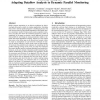283 search results - page 7 / 57 » Effective Program Verification for Relaxed Memory Models |
SC
2005
ACM
15 years 5 months ago
2005
ACM
The memory consistency model in parallel programming controls the order in which operations performed by one thread may be observed by another. Language designers have been reluct...
113
click to vote
ASPLOS
2010
ACM
15 years 2 months ago
2010
ACM
Online program monitoring is an effective technique for detecting bugs and security attacks in running applications. Extending these tools to monitor parallel programs is challeng...
DAC
2004
ACM
16 years 17 days ago
2004
ACM
The increasing complexity of today's mixed-signal integrated circuits necessitates both top-down and bottom-up system-level verification. Time-domain state-space modeling and...
104
click to vote
CASCON
2001
15 years 1 months ago
2001
Automated verification tools vary widely in the types of properties they are able to analyze, the complexity of their algorithms, and the amount of necessary user involvement. In ...
102
click to vote
CAV
2008
Springer
15 years 1 months ago
2008
Springer
Hangal et. al. [3] have developed a procedure to check if an instance of the execution of a shared memory multiprocessor program, is consistent with the Total Store Order (TSO) mem...

